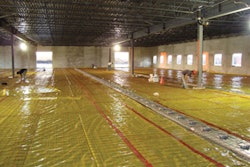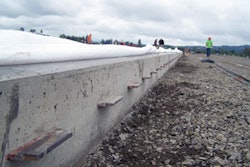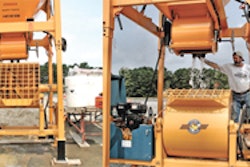PCA expects 2009 will represent this recession's trough for the United States' total cement consumption - reflecting a 26.6 percent decline (portland cement - 26.3 percent) from weak 2008 levels. The cyclical downturn in total cement consumption, measured peak-to-trough, represents a 54 million metric ton decline from 2005 peak levels - the worst volume decline in history. This downturn has coincided with a period of aggressive expansion and modernization. Large market imbalances have materialized, resulting in a contraction of import supply, excess inventory accumulation, low utilization rates, extended maintenance downtime, sporadic furloughs, and plant shutdowns. Unfortunately, the gains in cement consumption expected for next year are expected to be meager and probably back-ended. This implies current harsh conditions facing the industry will persist through 2010 and beyond. Utilization rates are not expected to reach 80 percent until 2012.
The fundamentals for a recovery in construction
While recent economic government reports regarding third quarter real GDP growth of 3.5 percent may suggest a technical end of the recession, the conditions facing residential and nonresidential construction are likely to remain critically weak for another year or more. The construction fundamentals will not begin to improve until labor markets have stabilized. Roughly six to nine months after the economy stops shedding jobs, foreclosure activity will decline, real estate prices will stabilize and the perceived risks in lending by banks will ease. The dual combination of a recovery in the labor market and an easing in lending standards are the basis upon which the potential for a robust recovery in construction markets will be built. Lacking either condition suggests a delayed and muted recovery.
The prospects for a return to job creation are distant. PCA expects job losses will stop in the first quarter, followed by a saddle point quarter characterized by minor monthly losses/gains essentially leaving quarterly job losses at zero. When all is totaled, more than 7.8 million jobs are expected to be lost during the recession that began in December 2007. Job gains are expected to materialize early in the third quarter followed by successive strengthening in labor markets. This period of strengthening yields between 350,000 to 500,000 net jobs created in 2010. Roughly three million net jobs are expected to be created in 2011 and 2012. While these net job gains may seem optimistic to some, PCA projections for year-end employment in 2012 remains below December 2007 levels (onset of the recession).
Credit issues will also constrain a meaningful recovery in 2010. The critical issue facing the economy is not the level of capital available, but rather access to the capital by business and consumers. Limited access to capital has arisen due to banks' aversion toward risk and increases in risk associated with a weak economy. It is likely that banks' aversion toward risk will diminish only after charge-offs for loans show a sustained pattern of decline. Unfortunately, loan charge-offs are expected to accelerate as unemployment increases. PCA expects an easing in lending standards will begin to materialize roughly six to nine months after labor markets stabilize. Stabilization in the labor markets implies less risk in borrowers' ability to pay back loans but also should lead to a reduction in loan charge-offs and, hence, risk aversion.
The easing of credit standards is not expected to materialize in a synchronized fashion across all sectors of the economy. Lender risk varies with the borrower. Easing in lending standards is expected to materialize first in the residential sector. By late 2010/early 2011, PCA expects declining home prices will have run its course and modest home price increases will begin to emerge. Rising home values, coupled with stabilization of the labor markets, suggest a significant reduction in lending risks.
The ease in lending standards for nonresidential loans is expected to lag residential by one to two quarters. The improvement process for fundamentals in nonresidential is longer than residential. Improvement in nonresidential economic fundamentals begins with stabilization in the labor markets, but these gains must then be translated into higher occupancy rates, lower vacancy rates, and firmer leasing rates. This additional translation takes time. Furthermore, PCA expects nonresidential property prices will continue to decline through late 2011. These factors, coupled with the existing credit issues surrounding nonresidential loans, suggest a longer recovery will materialize for nonresidential loans.
Construction sector performance
The residential sector has largely run its course as a significant contributor to construction declines. The expectation of a slow reduction in home inventories suggests that this sector will likely be a neutral contributor to cement consumption growth rates through mid-2010. Whatever gains materialize in the meantime will be meager. Despite the stabilization in residential construction, nonresidential construction is expected to exert a significant drag on construction activity during 2010. By 2011, the nonresidential drag on growth is expected to become milder and is expected to become a contributor to growth by the end of 2011. Substantial gains are expected to materialize in nonresidential construction in 2012 and beyond. These gains in nonresidential construction activity are expected to coincide with gains in nonresidential cement intensities - amplifying gains in cement consumption.
Given the weak outlook for private sector construction, any near-term turn in overall construction activity and cement consumption will be dictated by public construction. While attention is focused on the timing and magnitude of the potential positive impacts on construction arising from the American Recovery and Reinvestment Act (ARRA), keep in mind that more than 90 percent of all highway and street spending is put-in-place by state and local governments. State fiscal conditions impact discretionary public construction spending, and the harsh economic environment facing state and local governments may result in a double-digit decline in discretionary highway/street spending during 2009, followed by another large decline in 2010. The harsh fiscal picture facing state and local governments will partially sterilize the ARRA impacts for street and highway construction. The extent to which this materializes could pose significant risks to PCA's cement projections.
Furthermore, ARRA highway spending, at least initially, is likely to be dominated by highway preservation activities such as resurfacing. While some benefit will be accrued to cement consumption, as a whole, these projects are likely to carry low cement intensities - further muting the potential near-term stimulatory benefit to cement consumption.
Finally, bureaucratic delays have hindered the release of ARRA highway funds. Through September, highway outlays represented a meager 8.9 percent of total apportionments. These represent levels that were expected to be achieved in June-July by PCA. Outlays, however, are accelerating on a month over month basis. Allowing for lags between outlays and cement usage during the stages of construction suggests that very little second half stimulatory impact from ARRA will materialize during 2009. Delays in the release of ARRA monies imply that some of the outlays that were previously expected to materialize in 2009 will likely materialize later - boosting the potential stimulatory impact of ARRA in 2010-2011.
Taken together, PCA does not expect a sustained and significant improvement in construction activity or cement consumption to materialize until the second half of 2010. By that time, the economy is expected to be creating jobs and ensuring a sustained recovery. Substantial percentage gains in cement consumption are expected to materialize during 2011-2014.


















